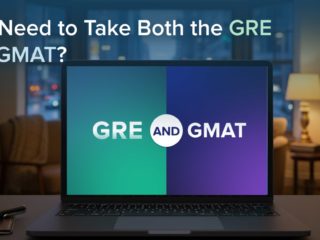| Getting your Trinity Audio player ready... |
Most test-takers in the midst of their GRE prep have encountered some tough GRE math questions. To assist you in learning to tackle such challenging questions, this article will present you with 10 hard GRE math problems and some math tips that will help you solve them.
Here are the topics we’ll cover:
- The GRE Quant Sections
- An Overview of the GRE Question Types
- The Math Topics Tested on the GRE
- Don’t Forget About the GRE Subtopics
- Tough GRE Math Questions
- Summary
- What’s Next?
Let’s start with an overview of the GRE quantitative sections.
The GRE Quant Sections
There are 4 sections on the GRE, and 2 of those sections are Quant. The first Quant section is 21 minutes and contains 12 questions, and the second is 26 minutes and contains 15 questions. Keep in mind that you are allowed to use an onscreen calculator for all Quant sections. However, you need to ensure that you do not overuse that calculator as you are solving questions. This is one of many math strategies you must learn throughout your GRE math prep.
KEY FACT:
There are 2 GRE Quant sections, and you are given a total of 47 minutes to answer 27 questions.
Now, let’s discuss the types of GRE math problems you’ll encounter in the math sections.
An Overview of the GRE Question Types
There are 4 types of GRE math questions:
- Multiple-Choice (single answer choice)
- Quantitative Comparison
- Multiple-Choice (multiple answer choices)
- Numeric Entry
KEY FACT:
You will encounter 4 main types of Quant questions on the GRE.
Let’s go through a few key details of each question type. If, after reading this section, you’d like a more detailed look at the quant question types, you can read our GRE Quant section breakdown, or you can obtain more information from ETS about the GRE Quant section.
Single-Answer Multiple-Choice Questions
A single-answer multiple-choice question is your typical math problem-solving question. In fact, if you have done any GRE math practice, then you likely have answered these questions. Each question has 5 answer choices, and you must select 1 of the 5 as the correct answer.
Quantitative Comparison Questions
Quantitative comparison (QC) questions are a question type you most likely have never seen before. However, the good news is that as you work through your math study guide or self-study course, you’ll see that QC questions are not always among the most difficult math problems.
Quantitative Comparison questions ask us to determine the relationship between 2 quantities. You can see QC questions in both basic and advanced math questions.
Multiple-Answer Multiple-Choice Questions
Multiple-answer multiple-choice questions are similar to single-answer multiple-choice questions, except you must select 1 or more answer choices. Also, this question type can be associated with any Quant topic, even data analysis problems.
Numeric Entry Questions
Numeric entry questions are quite similar to multiple-choice questions, with 1 major difference. In this question type, we are not provided any answer choices, so we must enter the correct answer into the answer box.
Now that we are up to speed regarding the GRE Quant question types, let’s discuss the GRE Quant math topics.
The Math Topics Tested on the GRE
GRE quant is challenging due in part to the large number of topics that are tested. They run the gamut from arithmetic to algebra to probability. Here is a more detailed list:
- Basic Arithmetic
- Linear and Quadratic Equations
- Number Properties
- Roots
- Exponents
- Inequalities
- Absolute Values
- General Word Problems
- Rates
- Work Problems
- Unit Conversions
- Ratios
- Percents
- Statistics
- Overlapping Sets
- Combinations and Permutations
- Probability
- Geometry
- Coordinate Geometry
- Sequences
- Functions
- Data Analysis
- Data Interpretation
KEY FACT:
There are 23 major quant topics on the GRE.
Lastly, before going through GRE math questions and answers, let’s discuss GRE math subtopics.
Don’t Forget About the GRE Subtopics
It’s important to understand that there are many GRE math subtopics contained in the 23 major topics mentioned above. For example, you may think that Number Properties is just 1 big topic. However, there are numerous subtopics within Number Properties. These subtopics have their own sets of math formulas and strategies that you must learn. For example, some Number Properties subtopics are:
- divisibility
- remainders
- least common multiple
- greatest common factor
- units digit patterns
- even and odd numbers
- positive and negative numbers
So, to be successful in learning GRE Quant, make sure that you don’t forget about the hundreds of subtopics you must learn as you encounter each major topic. In fact, one reason you may struggle with some of the hardest GRE math questions is that there are so many micro-subtopics. So be sure that you hit on all these various subtopics when you’re doing your GRE practice math questions.
TTP PRO TIP:
You must master the many GRE math subtopics as you learn GRE math.
Now that we’ve completed our discussion of the math topics, let’s jump into some hard GRE math practice questions.
Tough GRE Math Questions
Let’s take a look at 10 hard math sample questions. Try to work out each solution before looking at it!
GRE Math Question 1: Sum of Squares
Quantity A:
5002 + 6002 + 9002
Quantity B:
(500 + 600 + 900)2
- Quantity A is greater.
- Quantity B is greater.
- The two quantities are equal.
- The relationship cannot be determined from the information given.
Solution:
Although we may be tempted to actually do the math using the online calculator, we must instead remember the following rule:
(a + b + c)2 = a2 + b2 + c2 + 2ab + 2ac + 2bc
Using the above identity, we see that the expansion of (500 + 600 + 900)2 will contain the terms 5002, 6002, and 9002, plus several other terms, all of which are positive.
Therefore, without calculating each quantity, we can safely conclude that (500 + 600 + 900)2 is much larger than 5002 + 6002 + 9002.
Thus, Quantity B is greater than Quantity A.
Answer: B
GRE Math Question 2: Percents
A particular item of clothing was originally priced at N dollars, where N is a positive integer. However, during a closeout sale, the item was sold for just 6 percent of its original price. Which of the following could be the sale price of the rug?
- 33
- 38
- 50
- 58
- 62
Solution:
We are given that the original price equals N, and we can let the sale price = W. Since the closeout price W is 6% of N, we can re-express 6% as 6/100 and create the following equation:
W = 6N/100
W = 3N/50
50W = 3N
50W/3 = N
We know that N is an integer, so 50W/3 must also produce an integer. Since 50 is not a multiple of 3, W must be. Of our answer choices, the only one that is a multiple of 3 is 33, so the correct answer is A.
Answer: A
GRE Math Question 3: Exponential Equations
If 7x – 7x-2 = 48(76), what is the value of x?
- 4
- 6
- 8
- 10
- 12
Solution:
First, we can rewrite the equation as:
7x – 7x-2 = 48(76)
7x – (7x)(7-2) = 48(76)
Next, we can factor out 7x, giving us:
7x(1 –7-2) = 48(76)
7x(1 –1/49) = 48(76)
7x(48/49) = 48(76)
7x = 48(76) * 49/48)
7x = 76 * 49
7x = 76 * 72
7x = 78
x = 8
Answer: C
GRE Math Question 4: Inequalities
9n – 2m > 0 and 3m – 2 > 8n
Quantity A:
n + m
Quantity B:
2
- Quantity A is greater.
- Quantity B is greater.
- The two quantities are equal.
- The relationship cannot be determined from the information given.
Solution:
Note that Quantity A is the expression n + m. This is an important hint: We don’t actually need to try to find individual values for our variables. Rather, we should look for a way to use the 2 inequalities in the stem to produce the expression n + m.
We are given that 9n – 2m > 0 and 3m – 2 > 8n.
We can rewrite 3m – 2 > 8n as 3m – 8n > 2.
Let’s add the inequalities 3m – 8n > 2 and 9n – 2m > 0.
Doing so gives us:
m + n > 2
Thus, Quantity A is greater than Quantity B.
Answer: A
GRE Math Question 5: Rates
Hanna and Julie leave home to go to the same office, from the same house, taking the same 30-mile route. If Hanna’s speed is 1/4 greater than Julie’s, and Hanna arrives at work 10 minutes before Julie, what was Hanna’s rate driving from home to work?
- 18
- 24
- 28
- 32
- 36
Solution:
We can let Julie’s speed = r. Since Hanna’s speed is 1/4 greater than Julie’s, Hanna’s speed is (1 + 1/4) of Julie’s, so Hanna’s speed = 5r/4.
Since they both went 30 miles, we can determine both the times in terms of 4.
time = distance/rate
So, Julie’s time is:
30/r
Hanna’s time is:
30/(5r/4) = 120/5r = 24/r
Finally, since Hanna arrived 10 minutes (or 1/6 of an hour) before Julie, we can create the following equation:
30/r = 1/6 + 24/r
6/r = 1/6
r = 36
Answer: E
GRE Math Question 6: Wet Mixtures
Iodine solution A, which contains 30 percent iodine, is mixed with 30 liters of iodine solution B, which contains 10 percent iodine. If the final mixture contains 18 percent iodine, how many liters of iodine solution A were used to produce the final mixture?
- 18
- 20
- 24
- 28
- 32
Solution:
Let’s let x be the number of liters of solution A. Thus, we can express the amount of iodine in solution A as 0.30x. Similarly, the amount of iodine in the 30 liters of 10% iodine in solution B is 0.10(30). Finally, the resulting mixture has (x + 30) liters of 18% iodine, and the amount of iodine is 0.18(x + 30). We can express this information in the equation as:
0.30x + 0.10(30) = 0.18(x + 30)
0.30x + 3 = 0.18x + 5.4
0.12x = 2.4
x = 20
Answer: B
GRE Math Question 7: Weighted Averages
The test score average for the students in classroom A is 100. The test score average for the students in classroom B is 160. If the average score for both classes combined is 120, what is the ratio of the number of students in class A to the number of students in class B?
Indicate all such answers.
- 4 to 2
- 5 to 8
- 4 to 1
- 8 to 4
- 10 to 3
- 20 to 10
Solution:
We can create the following equation in which the number of students in classroom A = A and the number of students in classroom B = B.
120 = (100A + 160B)/(A + B)
120A + 120B = 100A + 160B
20A = 40B
A/B = 40/20 = 2/1
We see that 4 to 2, 8 to 4, and 20 to 10 are all in a 2-to-1 ratio.
Answer: A, D, and F
GRE Math Question 8: Combinations
In the kitchen of a restaurant, a crew of 4 chefs is to be selected from among 5 main chefs and 6 sous-chefs. If the crew must have at least 2 main chefs, in how many ways can the chefs be selected?
- 200
- 210
- 215
- 230
- 245
Solution:
Make sure you have carefully read the question stem, noting that the phrase “at least” indicates 3 possible scenarios, as shown below.
Scenario 1: 2 main chefs and 2 sous-chefs
The number of main chefs can be selected in 5C2 ways:
5C2 = (5 x 4)/2! = 5 x 2 = 10 ways
The number of sous-chefs can be selected in 6C2 ways:
6C2 = (6 x 5)/2! = 3 x 5 = 15 ways
Thus, the number of ways to select 2 main chefs and 2 sous-chefs is 15 x 10 = 150.
Scenario 2: 3 main chefs and 1 sous-chef
The number of main chefs can be selected in 5C3 ways:
5C3 = (5 x 4 x 3)/3! = 5 x 2 = 10 ways
The number of sous-chefs can be selected in 6C1 ways:
6C1 = 6 ways
Thus, the number of ways to select 3 main chefs and 1 sous-chef is 6 x 10 = 60.
Scenario 3: 4 main chefs and 0 sous-chefs
We just need to select 4 main chefs. Those chefs can be selected in 5C4 ways:
5C4 = 5 ways
Thus, the number of ways to select at least 2 main chefs for the crew of 4 is:
150 + 60 + 5 = 215
Answer: C
GRE Math Question 9: Angles and Sides of a Triangle
In triangle ABC, x < y < z. Side AC = 10 and side BC = 6. Which of the following are possible perimeters of triangle ABC?
Indicate all such answers.
- 22
- 24
- 26
Solution:
We use the rule that the smallest side of a triangle is always opposite the smallest angle, and the longest side of a triangle is always opposite the largest angle.
Thus, we see that side BC, which is opposite the smallest angle x, is the shortest side of the triangle.
Accordingly, side AC is the longest side of the triangle because it is opposite the largest angle z.
Thus, the length of side AB is between the lengths of BC and AC.
Since side AC = 10 and side BC = 6, the length of side AB must be greater than 6 but less than 10. That is, 6 < AB < 10.
Since we are given the lengths of sides AC and BC and the lengths of 3 possible perimeters, we can determine the possible lengths of side AB. Let’s go through each answer choice.
A) Perimeter = 22
Perimeter = side AB + side AC + side BC
22 = AB + 10 + 6
AB = 6
We know that 6 is not a possible length of AB, since AB must be between 6 and 10.
B) Perimeter = 24
Perimeter = side AB + side AC + side BC
24 = AB + 10 + 6
AB = 8
We know that 8 is a possible length of AB, since AB must be between 6 and 10.
C) Perimeter = 26
Perimeter = side AB + side AC + side BC
26 = AB + 10 + 6
AB = 10
We know that 10 is not a possible length of AB, since AB must be between 6 and 10.
Thus, the only correct answer is choice B.
Answer: B
GRE Math Question 10: Data Interpretation
The graph above shows the amount (in millions of dollars) of income tax that six CEOs paid in 2014.
If a seventh CEO, Calvin Signorelli, who paid a certain amount of income tax in 2014, were added to the data presented in the chart, there would be exactly one mode, and the average (arithmetic mean), median, and mode would be equal. In 2014, how many dollars in income tax did Calvin Signorelli pay?
- 19 million
- 20 million
- 21 million
- 22 million
- 23 million
Solution:
Let’s let x = the amount (in millions) of income tax that Calvin Signorelli paid in 2014. Therefore, our values for taxes paid are: 6, 8, 10, 12, 12, 14, and x.
It’s important to notice that if there is exactly 1 mode, that mode must be 12, since there are already 2 values of 12 in the set and no other value occurs more than once. Since we know the mode is 12, and since we know that the average is equal to the mode, we can set the average of the 7 integers equal to 12.
Average = sum/quantity
12 = (6 + 8 + 10 + 12 + 12 + 14 + x) / 7
84 = 62 + x
22 = x
Thus, Calvin Signorelli paid 22 million in taxes in 2014.
Answer: D
Summary
In the realm of even the toughest GRE math questions, the GRE Quant section tests students on 23 main math topics and hundreds of subtopics.
There are 4 main Quant question types: traditional multiple-choice, multiple-choice with multiple possible answers, Quantitative Comparison, and Numeric Entry. You should be familiar with each type of question and ensure that you spend adequate time learning and mastering Quantitative Comparison questions.
In this article, we worked through 10 difficult sample GRE math questions, covering the following topics: sum of squares, percents, exponential equations, inequalities, rates, wet mixtures, weighted averages, combinations, triangles, and data interpretation. These are GRE math examples that you may encounter when you take the exam.
What’s Next?
The GRE quantitative section is not a walk in the park. Part of your preparation is, of course, an intensive study of the topics covered in GRE Quant and engaging in plenty of GRE math practice. But nearly as important is your ability to answer GRE questions quickly and efficiently. If you concentrate on both the study material and good testmanship, you’ll give yourself the best chance of earning the GRE quant score you desire.



